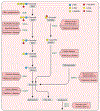Genetic defects in the sphingolipid degradation pathway and their effects on microglia in neurodegenerative disease
- PMID: 33296739
- PMCID: PMC7775721
- DOI: 10.1016/j.cellsig.2020.109879
Genetic defects in the sphingolipid degradation pathway and their effects on microglia in neurodegenerative disease
Abstract
Sphingolipids, which function as plasma membrane lipids and signaling molecules, are highly enriched in neuronal and myelin membranes in the nervous system. They are degraded in lysosomes by a defined sequence of enzymatic steps. In the related group of disorders, the sphingolipidoses, mutations in the genes that encode the individual degradative enzymes cause lysosomal accumulation of sphingolipids and often result in severe neurodegenerative disease. Here we review the information indicating that microglia, which actively clear sphingolipid-rich membranes in the brain during development and homeostasis, are directly affected by these mutations and promote neurodegeneration in the sphingolipidoses. We also identify parallels between the sphingolipidoses and more common forms of neurodegeneration, which both exhibit evidence of defective sphingolipid clearance in the nervous system.
Keywords: Aging; Alzheimer's disease; Microglia; Parkinson's disease; Sphingolipidoses; Sphingolipids.
Published by Elsevier Inc.
Conflict of interest statement
Declarations of interest: None
Figures


Similar articles
-
Pathology and current treatment of neurodegenerative sphingolipidoses.Neuromolecular Med. 2010 Dec;12(4):362-82. doi: 10.1007/s12017-010-8133-7. Epub 2010 Aug 22. Neuromolecular Med. 2010. PMID: 20730629 Review.
-
Characterization of Drosophila Saposin-related mutants as a model for lysosomal sphingolipid storage diseases.Dis Model Mech. 2017 Jun 1;10(6):737-750. doi: 10.1242/dmm.027953. Epub 2017 Apr 7. Dis Model Mech. 2017. PMID: 28389479 Free PMC article.
-
Neuronal sphingolipidoses: Membrane lipids and sphingolipid activator proteins regulate lysosomal sphingolipid catabolism.Biochimie. 2016 Nov;130:146-151. doi: 10.1016/j.biochi.2016.05.004. Epub 2016 May 5. Biochimie. 2016. PMID: 27157270 Review.
-
Sphingolipids and neuronal degeneration in lysosomal storage disorders.J Neurochem. 2019 Mar;148(5):600-611. doi: 10.1111/jnc.14540. Epub 2018 Aug 16. J Neurochem. 2019. PMID: 29959861 Review.
-
My journey into the world of sphingolipids and sphingolipidoses.Proc Jpn Acad Ser B Phys Biol Sci. 2012;88(10):554-82. doi: 10.2183/pjab.88.554. Proc Jpn Acad Ser B Phys Biol Sci. 2012. PMID: 23229750 Free PMC article. Review.
Cited by
-
Exploring the Potential Mechanism of Action of Ursolic Acid for Parkinson's Disease: An Integrative Network Pharmacology, Docking and Molecular Dynamics Study.Mol Neurobiol. 2025 Jun 24. doi: 10.1007/s12035-025-05145-4. Online ahead of print. Mol Neurobiol. 2025. PMID: 40551052
-
Icariin: A Potential Neuroprotective Agent in Alzheimer's Disease and Parkinson's Disease.Neurochem Res. 2022 Oct;47(10):2954-2962. doi: 10.1007/s11064-022-03667-0. Epub 2022 Jul 8. Neurochem Res. 2022. PMID: 35802286 Review.
-
Transcriptional suppression of sphingolipid catabolism controls pathogen resistance in C. elegans.PLoS Pathog. 2023 Oct 31;19(10):e1011730. doi: 10.1371/journal.ppat.1011730. eCollection 2023 Oct. PLoS Pathog. 2023. PMID: 37906605 Free PMC article.
-
Myeloid-derived β-hexosaminidase is essential for neuronal health and lysosome function: implications for Sandhoff disease.bioRxiv [Preprint]. 2024 Oct 22:2024.10.21.619538. doi: 10.1101/2024.10.21.619538. bioRxiv. 2024. PMID: 39484433 Free PMC article. Preprint.
-
Microglial replacement in a Sandhoff disease mouse model reveals myeloid-derived β-hexosaminidase is necessary for neuronal health.Nat Commun. 2025 Aug 27;16(1):7994. doi: 10.1038/s41467-025-63237-0. Nat Commun. 2025. PMID: 40866328 Free PMC article.
References
-
- Hannun YA, Obeid LM, Principles of bioactive lipid signalling: lessons from sphingolipids, Nat Rev Mol Cell Biol 9(2) (2008) 139–50. - PubMed
-
- Sandhoff R, Sandhoff K, Emerging concepts of ganglioside metabolism, FEBS Lett 592(23) (2018) 3835–3864. - PubMed
-
- Ledeen RW, Yu RK, Gangliosides-structure, isolation, and analysis., Methods Enzymol. 83 (1982) 139–191. - PubMed
-
- Tettamanti G, Ganglioside/glycosphingolipid turnover: new concepts, Glycoconj J 20(5) (2004) 301–17. - PubMed
Publication types
MeSH terms
Substances
Grants and funding
LinkOut - more resources
Full Text Sources
Other Literature Sources
Medical

